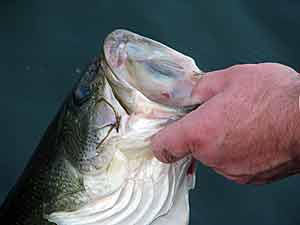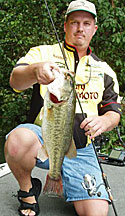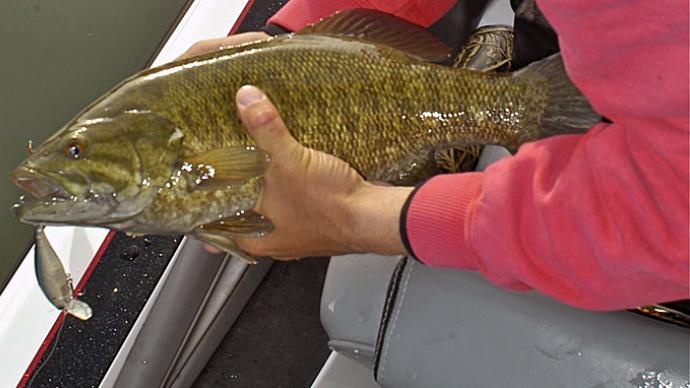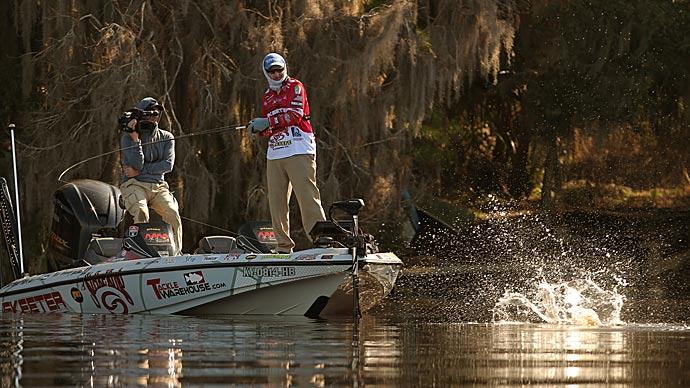
With top-name pros like Gary Klein, Takahiro Omori, Kevin Van Dam, Tommy Martin, Gary Yamamoto, Aaron Martens, and many others relying more and more on fluorocarbon line, you really can't help but to listen to some of the talks about this line. Big-name tournaments are being won on fluorocarbon lines left and right. The pros' feedback is optimistic that this could be the next best thing since nylon monofilament was invented in the early 1900s. Fluorocarbon lines are, without a doubt, a mega-trend in bass fishing lines. Read further to find out why.
Before I go further, I want to explain precisely what fluorocarbon line is and a little about the history of this line. As far as I can research on the internet, fluorocarbon was invented in the 1970s in Japan. Still, it wasn't until the mid 90's that fluorocarbon was introduced as a fishing line, so yes, it is relatively new to the fishing industry, and we have just begun to see its effect. Many of the early generation fluorocarbons were very stiff, hard to manage, and not to mention very, very expensive at a whopping $1 per yard. Still, the new processing techniques have enabled the modification of the stiff polymer chains to make this material more flexible, manageable, and affordable. This results in the branching of the polymer backbone and enables the tailoring of properties and improved performance in handling.
Before fluorocarbon was first introduced into bass fishing, it was used primarily by fly fishermen as tippets and saltwater enthusiasts as leader line due to its invisible properties, stiffness, strength, and abrasion resistance. Most of the fluorocarbon lines are made from a fluoropolymer called polyvinylidene fluoride...PVDF for short. PVDF is a high-grade engineering polymer with good temperature properties and excellent chemical resistance. You don't see much of it around the house, but it is used for a lot of piping, valves, seals, musical instrument strings, and air filters. In addition, it has several other applications in the electronics industry, such as membranes for fuel cells and batteries.
Do remember that fluorocarbon lines are a type of monofilament lines. Mono is simply standing for mono or single filament. So typically, I will use the phrase nylon monofilament to distinguish between itself and fluorocarbon lines.
So what are the advantages of this fluorocarbon line over the tried and true nylon monofilament lines?
Advantages of Fluorocarbon
One of the primary advantages of fluorocarbon is its near invisibility when it is submerged under water. Fluorocarbon line comes the closest to the light refractive index of water, so it is virtually invisible when submerged. This fact alone makes this line useful in situations with a clear water environment. As a result, many anglers now use less-visible 16 lb. fluorocarbon for applications where they may have previously used more-visible 12-14 pound nylon mono. In addition, anglers can gain extra strength in their fluorocarbon lines due to the less visibility of fluorocarbon in the water.
Fluorocarbon's chemical composition and extrusion methods create a solid and durable line. In addition, most fluorocarbon lines are closed cellular. As a result, they do not absorb water like most nylon monofilaments, so their strength is maintained better than nylon monofilaments, which lose strength when exposed to water or humidity. Fluorocarbon is also unaffected by the sun's ultraviolet rays, causing fluorocarbon lines to last significantly longer than nylon monofilaments. I have noticed that fluorocarbon lines can last as long as four times the life of nylon monofilaments, making it an excellent choice for anglers looking for good value in fishing lines.
Yet another advantage of this space age line is that fluorocarbon has less stretch than typical nylon or copolymer monofilaments. As a result, your hook sets are always strong and positive, and this is a huge plus when fishing deep water finesse baits and at the very end of a long cast towards schooling fish with a Sammy, where line stretch is detrimental to a good hook set. The stretchiness characteristic of fluorocarbon lines is more comparable to that of braided lines than nylon monofilaments but without the thread look of braided lines that are easily seen in clear water. When flipping and pitching, your subtle bites will go from a barely detectable tap tap while using nylon monofilaments to bites like a bolt lighting up your rod's spine when using fluorocarbon. The bites are three times more noticeable in my hands while using fluorocarbon.
I have to tell a story about the sensitivity of fluorocarbon lines. While giving a tank seminar on jerkbaits at the Atlanta Boat Show earlier this year, I had one rod spooled with 10lb nylon monofilament and another with 10 lb fluorocarbon. I was using two rods to save time tying on another bait during the middle of a seminar. In this particular tank, the fish were starving and feeding heavily on almost anything you threw. I described the different actions between a pointer 78 and a flash minnow 95MR in the tank. While fishing the pointer 78 on monofilament, I could see the fish lightly hitting the bait and quickly spitting it out because the hard jerkbait didn't feel natural to the fish. I could barely if at all, feel those fish hit that pointer 78. But when I threw the flash minnow 95MR on the fluorocarbon, the fish just picked at the flash minnow just like they did the pointer 78, and the bites were highly distinguishable compared to those hits on pointer 78 using nylon monofilament. I taught myself a precious lesson that day, and it made me wonder how many fish have pocket picked my jerkbaits in the past while I was using nylon monofilament, and I didn't even know it. Even though the bites are subtle on inactive fish, I could have, at the very least, had the opportunity to swing on some of those pocket-picking fish in hopes of sticking them and getting them into the boat. But now that I use fluorocarbon, I will get that opportunity and never forget that test. I hope it will also give you, the reader,r something to think about.
Another advantage of fluorocarbon over a braided line is that fluorocarbon line sinks at much faster rates than nylon line or even much less dense braided lines, which will float. Because of the chemistry of the material and the dense packing of the crystal structures in the polymer chains, fluoropolymers are about 1.7 times as dense as nylon, which gives them a much faster sink rate. The fact that fluorocarbon sinks make it a better choice for baits that dive or sink, like crankbaits and deep jig fishing, and it can even help get your deep diving Lucky Craft jerkbaits like the Staysee 90 to get a little deeper than a braided line usually would get you.
The surface tension of water and the lower density can keep nylon monofilament from sinking under the water's surface. It often takes the weight of a lure to let the nylon monofilament break the surface tension and sink slowly once it gets wet. The nylon monofilament's dry portion, unaffected by the weight of the lure, often stays on the water's surface. Most anglers have seen this when fishing with artificial lures. Once the lure hits bottom, you will notice some of your line still on the water's surface, and any slack in the nylon line will float or arch, creating a bow in your line. It is most notable, especially when fishing at deeper depths. These bows and arches will not happen with fluorocarbon line. Fluoropolymers, even though they are hydrophobic or water-hating, will easily break the surface tension and sink faster than nylon monofilaments, even without the help of the weight of any artificial lure. This concept leads to a direct connection to your lure, essential when fishing deep water with any lure that is worked below the water's surface. It is common knowledge that big bows in your line reduce your ability to detect subtle strikes, especially in deep water. By using fluorocarbon line, you have just eliminated those effects.
The hard finish of fluorocarbon line also provides extreme abrasion resistance over nylon monofilaments. Because of this property, fluorocarbon has been offered as a leader material for saltwater enthusiasts for years. Still, recent improvements in the processing have enabled makers to manufacture it with enough flexibility to be used solely as a fishing line for bass.
Now that's the long list of advantages. Here is the short list of disadvantages, which are minor compared to the long list of advantages.
Disadvantages of Fluorocarbon
The disadvantage of MOST fluorocarbons is that they cost a bit more than nylon monofilaments. For example, some line companies sell fluorocarbon for $40 for a 110-yard spool. But coupled with the fact that fluorocarbon lasts four times longer than nylon monofilaments, you still come out way ahead in the value department, as nylon monofilaments ordinarily last for only a month or sometimes less under heavy use. The extra cost is because raw PVDF (fluorocarbon) resin costs about four to five times as much as nylon, and since the material is twice as dense as nylon, you get about half the yield from the same amount of resin. Fluorocarbon is also more time-consuming to process as compared to nylon monofilaments.
Since fluorocarbon is a sinking line, it can be considered a disadvantage for hard topwater baits such as walking the dog with a Lucky Craft Sammy or Gunfish. The line sinks so readily that it drastically hampers the action of almost all hard topwater baits. Because of this simple fact, I find nylon monofilament to be a better option for topwater fishing. However, there is no problem using fluorocarbon for most buzzbaits because there is no action to impart in most buzzer-style lures. Below is a rating chart of the top 7 criteria anglers use when purchasing their fishing lines. I found it interesting to see how fluorocarbon stacks up against the rest. Do remember that many other environmental variables come into play when choosing your fishing lines other than the seven criteria I have listed below, so make your choices based on your needs. For example, copolymers are very difficult to rate because of the many different variables you can use in a copolymer line. This chart includes the categories that we have already discussed.
Rating Chart
Are you using the correct line???
4 = being best; 1 = being worst


Joining Two Lines
Since the cost of fluorocarbon is at a premium price, I use nylon monofilament as backing on all of my baitcasting and spinning reel outfits to maximize the use of the fluorocarbon with minimal waste. If I already have a reel spooled with nylon mono, I will go into my yard on or on the water and make a long cast with a heavy topwater bait. Once my cast is complete, I have determined my maximum casting distance. I then strip off another 30 to 40 feet of nylon mono, cut my line, and then join the nylon monofilament with the fluorocarbon line and reel the fluorocarbon onto the reel spool. The extra 30 to 40 feet is a buffer for numerous reties and professional overruns if you have them. There is a myriad of knots that you can use for this purpose. I like to use either a J-knot or a double uni-knot to join the fluorocarbon to other lines. These knots will also work well with joining fluorocarbon to braid or to copolymer lines. Just follow the instructions above, i.e., slobber up heavily, make pretty knots, and a slow cinch.
Fluorocarbon Differences
To my knowledge, there are only three factories in the world capable of manufacturing fluorocarbon lines. Two of those factories are in Asia, and the bulk of fluorocarbon lines come from these two Asian factories. The reason why a lot of fluorocarbons fish exactly alike is that they come from the same factory. The other fluorocarbon factory is located in Germany, and they manufacture the Triple fish brand of fluorocarbon. Some fluorocarbon lines handle better, some are stronger, some are more invisible under water than others, and some are a copolymer of fluorocarbon, meaning they have nylon filaments combined with fluorocarbon. My opinion on copolymer fluorocarbons is that by adding nylon filaments to fluorocarbon, you are defeating the purpose of using 100% fluorocarbon. If you add nylon filaments to fluorocarbon, you have just made the line more visible underwater and reduced the line's sensitivity by adding more stretch to the line. So you might as well fish with 100% nylon monofilament since using a fluorocarbon copolymer line is cheaper.
A few things that I look at when studying the many different fluorocarbon lines is the clearness of the line. Some companies use low-quality fluoropolymers, which cause the line to take on a "milky" color, and some lines have a chalky substance on the line or spool, making the line more visible to the fish. The clearness differences can be easily seen when you put a quality fluorocarbon line next to a lesser-quality line. Then, of course, the cost will enter into the equation. Some excellent brands of fluorocarbon on the market do not cost an arm and a leg to purchase. However, the most significant way to save money is to buy bulk spools. Only a few select companies sell fluorocarbon in bulk spools, so be sure to check into that as a cost-saving idea.
Fluorocarbon Uses
Having mentioned all the advantages and disadvantages of fluorocarbon, what techniques are best for using fluorocarbon line in bass fishing? Before I mention the specifics of technique fishing with fluorocarbon, let me mention one often overlooked advantage of these lines: the excellent frictional properties. Fluoropolymers, by nature of their chemistry, are very slippery materials. Think about Teflon as the best-known example of a non-stick, slippery fluoropolymer. Besides, fluorocarbons won't stick and bind in knot tying like nylon monos, the other significant advantage of these smooth lines is the reduced friction and wear on guide surfaces. Low friction also offers advantages in both casting and retrieving and can translate into longer casts and smoother retrieves, especially under fighting loads. One slight disadvantage to the stiffer fluorocarbon lines would be casting very light baits, whereas a more flexible line type would improve. Softer, more flexible materials can minimize the feedback and interference of the line when casting light lures with a bit of momentum.
Aside from the material properties such as low friction, Fluorocarbon lines offer many advantages for specific techniques. Most dropshot pros almost use fluorocarbon line exclusively because drop shotting is technically a clear deep water finesse technique. Sensitivity is paramount for deep finesse fishing in depths of over 40 feet, and the limited stretch characteristics of fluorocarbon tie in very well with any deep water finesse tactics.
Flipping and Pitching is another technique I like using with fluorocarbon lines. Fluorocarbon is very abrasive resistant due to its hardness. For those of you who have to line watch with nylon monofilament, those days are over with fluorocarbon's sensitivity (minimal stretch) features. Those subtle bites become stronger, and you can react quickly to those bites before the fish blows your jig or creature bait out. Because fluorocarbon comes the closest to the light refractive index of water, it is virtually invisible to the fish when submerged. It is excellent for clear water flipping and pitching, whereas the braid is more visible in clear water. If you still need to watch your line, you can use a permanent sharpie marker to color parts of your line above the water while you are fishing your jig. Remember, since fluorocarbon has the same light refractive index as water, it is relatively invisible under water, so you can upsize your line with less-visible 16 lb. fluorocarbon for applications where they may have used more-visible 12-14 pound mono previously.
Fluorocarbon is also an excellent choice for fishing jerkbaits and crankbaits as well. Again, fluorocarbon has excellent abrasion resistance for cranking through heavy laydowns. In addition, because fluorocarbon is a sinking line with minimal stretch, you will have no problems detecting bites or pocket picks when fishing jerkbaits and cranks. You might even get more depth out of them than if you used a nylon monofilament or braided lines.
Spinnerbaits, swim baits, and traps are other great baits to use with fluorocarbon. The most significant advantage to using fluorocarbon with spinnerbaits, swim baits, and traps is setting the hook at the end of those long casts. When making a long cast in open water flats with spinnerbaits and traps, the line stretch of nylon monofilament is enough to cause you a weak hook set on those long-distance casts, especially if your rod is in the wrong position. But with the limited visibility and stretch of fluorocarbon lines, you will be sure that the fish doesn't see your line and get a decent hook set even if you have lousy fishing form.
I have always used my lines to feel and hold the fish after the hookset. Take advantage of the action of your rod to land the fish, and use a light drag if possible. If you are unfamiliar with the free-spooling technique of fighting a fish, I would strongly advise you to read up on this lethal fish-fighting technique even to further your development into a proficient fish-fighting angler and watch your landing percentages skyrocket tremendously.
Many people don't use fluorocarbon with topwater baits because the line tends to sink rather quickly. To alleviate this problem, I have gone up to 20lb fluorocarbon with my walking topwaters, such as the Sammy or Gunfish. Using a bigger diameter line with topwaters helps slow down the sinking characteristics of the fluorocarbon line. I also don't do a lot of stop-and-go retrieves with my topwater baits. I fish a lot for Spotted Bass, and they tend to like a faster retrieve anyway. However, if you need to do a stop-and-go retrieve, I would opt for a good nylon monofilament. I would not recommend the more significant line for baits like a G Splash or similar Pop R type bait primarily because the bigger diameter line seems to overpower such a small pop r style bait.
That pretty much sums everything up on this line that is becoming increasingly popular in bass fishing. There are many characteristics to take advantage of in fluorocarbon lines with minimal disadvantages. Since I have switched to fluorocarbon on all of my bait casters and spinning reels, I can honestly say that it is the best thing I have ever done to improve my fishing. So give it a try and take the tips and information I have given you here and see why this is the best thing to happen to bass fishing since the invention of nylon monofilament in the early 1900s. It's only the beginning of great things from this line.
Special thanks to Mark Gibson, a Materials Scientist from Stillwater, MN, for input into the technical portions of this article.

"Triton" Mike Bucca spends over 200 days on the water. He owns Mike's SpotCountry Guide Service (www.tritonmike.com) out of the Metro Atlanta area, where he guides on Allatoona Lake (one of the very few guides in the United States that specializes in catching Spotted Bass). He has been featured numerous times in various state and national publications such as Georgia Outdoor News, Huntsville Times, Cullman Times, Outdoor Life, and Gary Yamamoto's Inside Line. Additionally, he can often be seen giving various seminars at Bass Pro Shops, Atlanta Boat Show, and various Bass Clubs throughout the Atlanta area.
Mike is an avid participant on the BassResource.com forum boards, where he enjoys sharing and discussing the joys of fishing. In previous years, he has participated in the Anglers Choice and several other local trails with great success - even winning a brand new Triton boat. His sponsors include Gary Yamamoto's Custom Baits, Lucky Craft Lures, SOB Fishing Products, Bass Stalker Jigs, Quickdrop Sinkers, Triple Fish Lines, Motor Guide Trolling Motors, and Super Target Stores.




